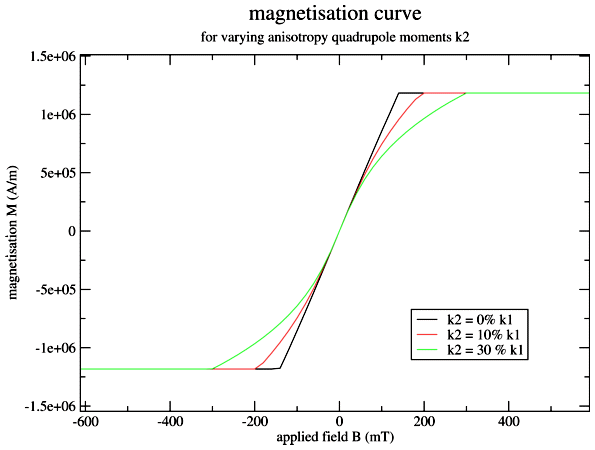Oxs Extension Module:
CED_UniaxialAnisotropy
Description:
This is a generic Oxs extension object, derived from the Oxs_Energy
class. It provides uniaxial anisotropy with second (K1) and fourth
(K2) order terms. In the easy axis case (K1>0) the energy density E
is computed by
E = K1|u×m|2
+ K2|u×m|4,
where m is the reduced (unit) magnetization and u is the
easy axis. Here the energy is zero if the magnetization is aligned
with the easy axis.
In hard axis case (K1<0) the energy is offset so that the zero point
occurs when the magnetization lies in the easy plane (i.e., orthogonal
to the hard axis). In this case the energy density is given by
E = -K1(u·m)2
- K2(u·m)4.
Either way, the field H is computed via the relation
µ0MsH =
2K1(u·m)u
+ 4K2(u·m)3u,
where Ms is the saturation magnetization.
This class was written and contributed by
Jürgen Zimmermann, Richard Boardman and Hans
Fangohr of the Computational Engineering and Design Group,
University of Southampton.
Installation:
Download the header and source code files below, and follow the general Oxs extension installation
instructions.
Usage:
MIF 2.x files written to use this class should include a Specify block
of the form
-
Specify CED_UniaxialAnisotropy:name {
- K1 k1_value
- K2 k2_value
- axis anisotropy_axis
- }
The values for the K1 and K2 parameters should be
scalar field objects, and axis should be a vector field
object. The only difference with respect to the stock
Oxs_UniaxialAnisotropy class is the inclusion of the K2 term.
Details:
- Authors: Jürgen Zimmermann, Richard Boardman, and Hans
Fangohr
- Affiliation: Computational Engineering and Design Group,
University of Southampton
- Oxs_Ext class: CED_UniaxialAnisotropy
- OOMMF releases: 1.2a3
- External libraries: none
- License: Public Domain
- Release date: 7-July-2004
Output from the three example MIF files, illustrating the effect of
increasing K2 relative to K1:
DISCLAIMER: This software was not
developed at and is not supported by the
National Institute of Standards and Technology. NIST assumes no
responsibility whatsoever for its use, and makes no guarantees,
expressed or implied, about its quality, reliability, or any other
characteristic.
Back to
Oxs extensions, or

This page maintained by [email protected]
27-Nov-2006


![]()